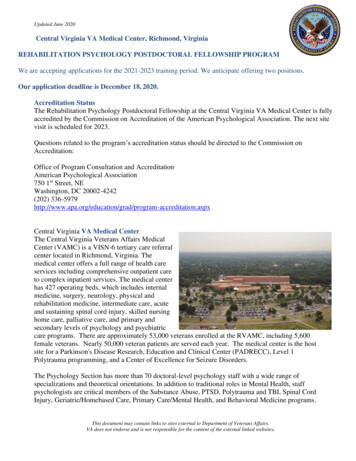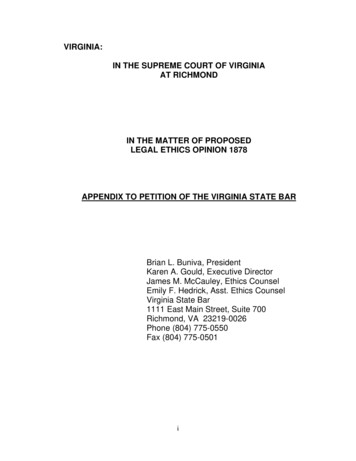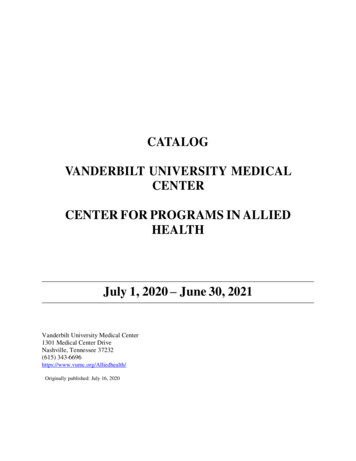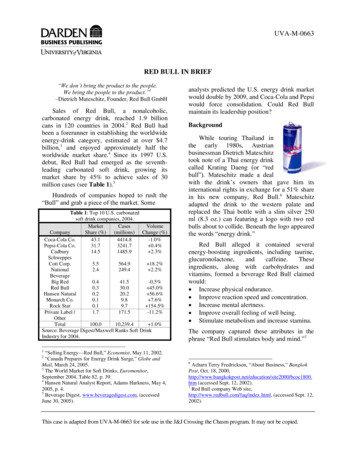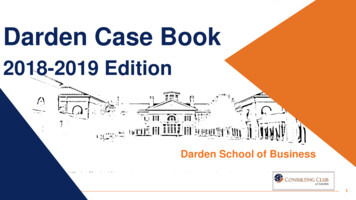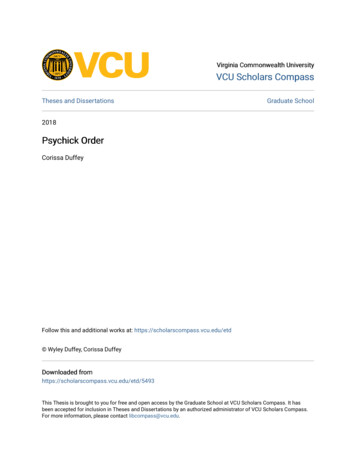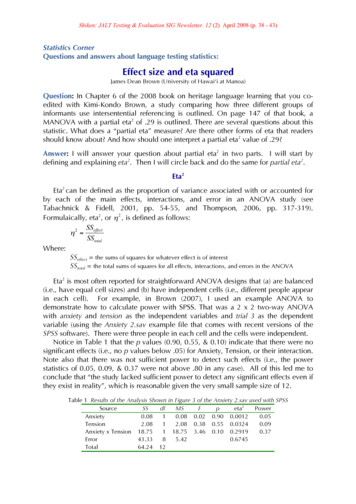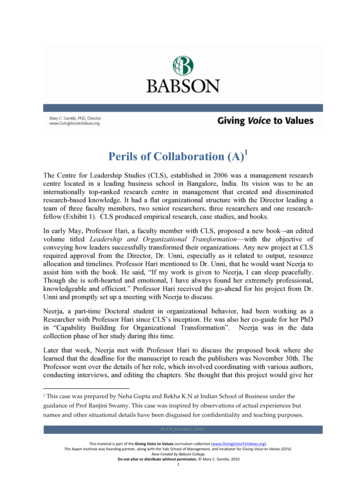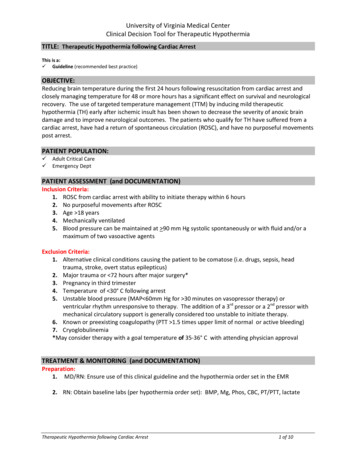
Transcription
University of Virginia Medical CenterClinical Decision Tool for Therapeutic HypothermiaTITLE: Therapeutic Hypothermia following Cardiac ArrestThis is a: Guideline (recommended best practice)OBJECTIVE:Reducing brain temperature during the first 24 hours following resuscitation from cardiac arrest andclosely managing temperature for 48 or more hours has a significant effect on survival and neurologicalrecovery. The use of targeted temperature management (TTM) by inducing mild therapeutichypothermia (TH) early after ischemic insult has been shown to decrease the severity of anoxic braindamage and to improve neurological outcomes. The patients who qualify for TH have suffered from acardiac arrest, have had a return of spontaneous circulation (ROSC), and have no purposeful movementspost arrest.PATIENT POPULATION: Adult Critical CareEmergency DeptPATIENT ASSESSMENT (and DOCUMENTATION)Inclusion Criteria:1. ROSC from cardiac arrest with ability to initiate therapy within 6 hours2. No purposeful movements after ROSC3. Age 18 years4. Mechanically ventilated5. Blood pressure can be maintained at 90 mm Hg systolic spontaneously or with fluid and/or amaximum of two vasoactive agentsExclusion Criteria:1. Alternative clinical conditions causing the patient to be comatose (i.e. drugs, sepsis, headtrauma, stroke, overt status epilepticus)2. Major trauma or 72 hours after major surgery*3. Pregnancy in third trimester4. Temperature of 30 C following arrest5. Unstable blood pressure (MAP 60mm Hg for 30 minutes on vasopressor therapy) orventricular rhythm unresponsive to therapy. The addition of a 3rd pressor or a 2nd pressor withmechanical circulatory support is generally considered too unstable to initiate therapy.6. Known or preexisting coagulopathy (PTT 1.5 times upper limit of normal or active bleeding)7. Cryoglobulinemia*May consider therapy with a goal temperature of 35-36 C with attending physician approvalTREATMENT & MONITORING (and DOCUMENTATION)Preparation:1. MD/RN: Ensure use of this clinical guideline and the hypothermia order set in the EMR2. RN: Obtain baseline labs (per hypothermia order set): BMP, Mg, Phos, CBC, PT/PTT, lactateTherapeutic Hypothermia following Cardiac Arrest1 of 10
University of Virginia Medical CenterClinical Decision Tool for Therapeutic Hypothermia3. RN: Determine availability of intravascular temperature management system (ThermoGard XPconsole and appropriate catheter; consoles located in CCU, MICU, and NNICU).MD: Determine presence of IVC filter: if none, MD to insert intravascular cooling catheter (ICY orQuattro) via femoral approach. If IVC filter is present, consider use of a shorter intravascularcooling catheter (CoolLine) via internal jugular or subclavian approach. Adjunctive coolingmethods will be necessary during initiation of cooling.4. RN/PCA: If an intravascular temperature management system is not available, obtain equipmentfor surface cooling per critical care nursing procedure #94C (one console and two hose setsshould be ordered from the Equipment Room)5. MD: Document post resuscitation neurologic exam in the medical record prior to patientcooling. A neurology consult should be considered, but should not delay the initiation ofcooling.6. MD: Place arterial line shortly after cooling begins in order to provide precise BP monitoring, aswell as access for required frequent labs and ABGs.Procedure: (refer to Appendix B-UVAHS Therapeutic Hypothermia Clinical Timeline)Phase I-Cooling:A. Initiate Cooling1. Initiate cooling as early as possible after ROSC.2. 33 C is the core temperature goal. If the patient has had major trauma or surgery less than3 days prior to arrest, a goal temperature of 35-36 may be considered.3. The goal temperature should be reached as rapidly as possible (ideally within 2 hours).RN: Convene Q2 hour team huddle until goal is reached.Internal Cooling Catheter (Preferred)External Surface Cooling System Initiate cooling process using 2 Pack patient in ice (groin, chest,liters of 4 C NS (kept in unit medaxillae, beneath neck). Follow Procedure for Inducedrefrigerator) administered rapidly(pressure bag) through either aHypothermia after Cardiac Arrestfemoral catheter or peripheralUsing Surface Cooling (PNSOvenous catheter. Not indicated ifCritical Care Procedure Manual,the patient has documentedprocedure 94C).pulmonary edema. If an intravascular temperaturemanagement system is available,follow steps in TemperatureControl Using an IntravascularCooling System (PNSO Critical CareProcedure Manual, procedure94B).4. RRT: Warm humidification on the ventilator during the cooling period is not recommended.5. MD/RN: Patients should NOT have an interruption of sedation (“sedation holiday”) for TTMduration.Therapeutic Hypothermia following Cardiac Arrest2 of 10
University of Virginia Medical CenterClinical Decision Tool for Therapeutic Hypothermia6. Team: Cooling should continue for 24 hours from the initiation of therapy. This is aguideline, and can therefore be adjusted depending on patient circumstances such asprolonged time to goal temperature or significant interruption of therapy resulting intemperature rise. “Resetting the clock” requires a team decision and attending physicianapproval, as well as explanation in a progress note.B. Medication: Shivering Prophylaxis (refer to Appendix C)MD/RN: Initiate fentanyl and midazolam for synergistic shivering prophylaxis as follows:1. Fentanyl: 50 mcg IV bolus followed by a maintenance infusion of 25-100 mcg/hr2. Midazolam: 2 mg IV bolus followed by a maintenance infusion of 2 to 8 mg/hrC. Shivering Management : refer to Appendix DTeam: Regular monitoring and aggressive treatment of shivering is vital. Besides the negativeeffects of heat generation, uncontrolled shivering can have significant, detrimental metaboliceffects. Surface counterwarming (forced warm air) should be employed as soon as any shiveringis noted.Phase II-Rewarming/Maintenance: (Appendix B- UVAHS Therapeutic Hypothermia Clinical Timeline)A. Begin rewarming once 24 total hours of cooling has occurred1. Use a slow rewarming approach of 0.25 C/hour until the patient reaches 36.5 C, then 2. Maintain patient at 36.5 C with the intravascular temperature management (IVTM) systemfor at least 24 hours, then 3. Discontinue active temperature maintenance (place IVTM system in “standby”) but continuemonitoring temperature until stable for 48 hours. The ICY and Quattro catheters have anFDA-approved 4 day dwell time and can be used for fever management. Other physical andpharmaceutical measures may also be used to maintain normothermia.B. Medication management (Appendix D)1. Discontinue neuromuscular blocking agent infusion (if used) at start of rewarming.2. Pharmacologic intervention may be necessary for shivering during the rewarming phase oftherapy to prevent rapid rewarming and its sequelae (see Appendix D).3. Titrate analgesics and sedatives for patient comfort until patient is rewarmed to 36.5 C .Monitoring/Documentation: RN: Continuous temperature monitoring from two sources is required for the duration oftherapy, including rewarming. Display both temperatures on the bedside monitor (via thehospital monitor interface accessory) for any patient receiving therapy with an IVTM system. RN: Documentation of peri-arrest information, hourly BSAS values, and therapies must beentered in the TTM flowsheet. MD: Obtain neurology consultation and EEG monitoring when neuromuscular blockade isutilized or if status epilepticus is suspected. RN: Obtain labs q4 h during active cooling and rewarming (see order set in EMR)Therapy Considerations: Therapeutic hypothermia is an urgent treatment priority post-cardiac arrest. Therefore, thebenefits of any off-unit procedure or imaging should be carefully weighed against theinterruption of cooling. If warranted, CT scan should be obtained prior to transfer to ICU.Therapeutic Hypothermia following Cardiac Arrest3 of 10
University of Virginia Medical CenterClinical Decision Tool for Therapeutic Hypothermia The management of electrolyte and acid base disturbances is essential. Serum potassium levelsare monitored closely as the serum level will decrease during the cooling phase of managementand increase during the rewarming period. A mild increase in lactic acid should also be expected.Glucose management: hypothermia causes increased insulin resistance, leading to elevatedglucose levels. Follow ICU glucose management protocols.PATIENT & FAMILY EDUCATION (and DOCUMENTATION)Family education is located in the UVA Repository PE 01094.POTENTIAL COMPLICATIONS (and DOCUMENTATION) .Electrolyte shifts are expected and must be monitored per the process set forth earlier.Dysrhythmias possible:-PR, QRS and QT interval prolongation-Tachycardia (expected upon initiation)-Bradycardia (expected as cooling progresses)-Atrial fibrillation-Very, very low risk of VT/VF with mild hypothermia (avoid overcooling)HAND-OFF OF CARE / DISCHARGE / FOLLOW-UP CARE (and DOCUMENTATION) Patients will be transferred out of the ICU or discharged home dictated by clinical progressionand overall health status as appropriate by clinical teamKey information must be recorded in the EMR on the TTM flow sheetOUTCOMES MEASURESThe goal of TTM is to discharge patients with neurological function equivalent to a CPC score of 1 or 2.CLINICIAN EDUCATION PLAN:*Nursing Education: New staff will attend a mandatory class presented by UVA TTM trainers. Trainersare selected by the TTM program coordinator.*TTM nurse champions will be chosen and educated for each ICU. Those champions will serve as unitexperts and provide updates to staff as new information is made available.*Fellows-Cardiology/Pulmonary-Critical Care/Surgical/Neurosciences Education: TTM coordinatorand/or TTM trainers will offer annual classes incorporating current evidence for hypothermia, clinicalpractice guideline and order set.*Resident Education: Podcasts are available; in services done upon request.ADDITIONAL INFORMATION:DEFINITIONS:TH: Therapeutic hypothermia is the induction and maintenance of a core body temperature between32 -34 Celsius for the purpose of mitigating the neurologic sequelae of cardiac arrestTTM: Therapeutic Temperature Management- collective term for several therapies, including THROSC: Return of Spontaneous Circulation (ROSC)-return of perfusing rhythm following resuscitationfrom cardiac arrestTherapeutic Hypothermia following Cardiac Arrest4 of 10
University of Virginia Medical CenterClinical Decision Tool for Therapeutic HypothermiaRASS: Richmond Agitation Sedation Scale-used to evaluate presence of delirium and sedation level inICU patients.BSAS: Bedside Shivering Assessment Scale-used for hypothermic patients to assess shivering intensity(Appendix C).CPC Scale: Cerebral Performance Category Scale-a scale in neurological medicine that grades a patient’sfunctional capacity response on a scale of 1-5, 1 being a return to normal cerebral function and 5 is braindeath. (Appendix B)REFERENCES:Kimberger, O., & Kurz, A. (2008). Thermoregulatory management for mild therapeutic hypothermia. BestPractice & Research Clinical Anaesthesiology, 22(4), 1.002Olson, D., Grissom, J. L., & Dombrowski, K. (2011). The evidence base for nursing care and monitoring ofpatients during therapeutic temperature management. Therapeutic Hypothermia & TemperatureManagement, 1(4), 209-217. man, K. H., & Herold, I. (2009). Therapeutic hypothermia and controlled normothermia in theintensive care unit: Practical considerations, side effects, and cooling methods. Critical Care Medicine,37(3), 1101-1120. Presciutti, M., Bader, M. K., & Hepburn, M. (2012). Shivering management during therapeutictemperature modulation: Nurses' perspective. Critical Care Nurse, 32(1), r, D. B., & Van der Kloot, T. E. (2009). Methods of cooling: Practical aspects of therapeutictemperature management. Critical Care Medicine, 37(7 Suppl), 81aa5badMedical dictionary. (2014). Retrieved from versity of Pennsylvania post cardiac arrest care/therapeutic temperature management order set,nursing orders and clinical practice guideline. (2013). Unpublished manuscript.Holzer, M., & Behringer, W. (2008). Therapeutic hypothermia after cardiac arrest and myocardialinfarction. Best Practice & Research Clinical Anaesthesiology, 22(4), 711-728.Nielsen, N., Wetterslev, J., al-Subaie, N., Andersson, B., Bro-Jeppesen, J., Bishop, G., . . . Friberg, H.(2012). Target temperature management after out-of-hospital cardiac arrest--a randomized, parallelgroup, assessor-blinded clinical trial--rationale and design. American Heart Journal, 163(4), 1.013Oddo, M., Schaller, M., Feihl, F., Ribordy, V., & Liaudet, L. (2008). From evidence to clinicalpractice: effective implementation of therapeutic hypothermia to improve patient outcome aftercardiac arrest. Critical Care Medicine, 34(7), 1865.Polderman, K. H. (2008). Induced hypothermia and fever control for prevention and treatment ofneurological injuries. Lancet, 371, 1955-1969.Therapeutic Hypothermia following Cardiac Arrest5 of 10
University of Virginia Medical CenterClinical Decision Tool for Therapeutic HypothermiaNielsen, N., Wetterslev, J., al-Subaie, N., Andersson, B., Bro-Jeppesen, J., Bishop, G., . . . Friberg, H.(2012). Targeted Temperature Management at 33 C vs 36 C after Cardiac Arrest. The New EnglandJournal of Medicine. 369:23.Boehm, J. (2007). A Chilling Review of Hypothermia. Code Communications Newsletter, 2:4.www.zoll.com.DISCLAIMER:Protocols contain a specific, established set of actions expected to be followed by clinicians. Guidelinesprovide evidence-based recommendations to assist practitioners in making decisions for patient care.However, guidelines and protocols are general and cannot take into account all of the circumstances ofa particular patient. Judgment regarding the propriety of using a specific protocol or guideline with aparticular patient remains with the patient’s physician, nurse, or other health care professional, takinginto account the individual circumstances presented by the patient. Care providers should documentany deviations from protocol / guideline in the patient’s electronic medical record, including therationale for deviation.REVISION HISTORYDateVersionDescription12/2015Owner(s)Name, Credentials, TitleMark AdamsCommitteeApproval*Patient CareCommitteeDate of Approval12/2015*Adults- Patient Care Committee approval is required if the guideline will be used in multiple areas or if the local area does nothave a practice committee to approve the guideline. If approval is required through other committees (such as patient safety,infection control, etc), please list those committees and dates of approval as well.*Pediatrics- Children’s Hospital Clinical Practice approval is required if the guideline will be used in multiple areas or if the localarea does not have a practice committee to approve the guideline. If approval is required through other committees (such aspatient safety, infection control, etc), please list those committees and dates of approval as well.Therapeutic Hypothermia following Cardiac Arrest6 of 10
University of Virginia Medical CenterClinical Decision Tool for Therapeutic HypothermiaAPPENDIX A: Clinical TimelineCoolingstarted (byany method)Cooling Phase*Shivering managedElectrolytes monitored q4hrLactate monitored q4hr x4Sedation maintained(no holiday)24 hours from start of cooling*0:0024:00:00Controlled rewarming phaseElectrolytes monitored q 4hrSedation maintained(no holiday)Patientreaches36.5 **ThermoGard remains onto actively maintainnormothermiaStop paralytic;begin sedation wean24 hoursApprox. 14 hours38:00:00ThermoGard placedin 'Standby' tomonitor patienttemperature12 hours 62:00:00* Cooling phase 'clock' starts with initial attempts to cool (prehospital, ED, ICU) by any method (iced NS infusion, ice bags, etc.), NOT from timethe IVTM catheter is inserted or goal temperature is reached.** Once patient is rewarmed to 36.5, DO NOT change anything with ThermoGard console settings for 24 hours. The patient is actively maintainedfor at least 24 hours at this temperature.Therapeutic Hypothermia following Cardiac Arrest7 of 10
University of Virginia Medical CenterClinical Decision Tool for Therapeutic HypothermiaAPPENDIX B: SHIVERING MANAGEMENTBedside Shivering Assessment Scale (BSAS)SCORETYPE OF SHIVERINGLOCATION0NoneNo shivering is detected on palpation of themasseter, neck, or chest muscles1MildShivering localized to the neck and thorax only2ModerateShivering involves gross movement of theupper extremities (in addition to neck andthorax)3SevereShivering involves gross movements of thetrunk and upper and lower extremitiesTherapeutic Hypothermia following Cardiac Arrest8 of 10
University of Virginia Medical CenterClinical Decision Tool for Therapeutic HypothermiaAppendix C:Therapeutic Hypothermia following Cardiac Arrest9 of 10
University of Virginia Medical CenterClinical Decision Tool for Therapeutic HypothermiaAppendix D: Shivering Prophylaxis / Pharmacological Management of ShiveringInduction of Hypothermia NO(BSAS 0)Fentanyl 50 mcg/hr continuous IVMidazolam 1 mg/hr continuous IV(given for synergistic antishivering effect)Shivering?YESBSAS 1-2-Monitor BSAS-Monitor forchanges totemperaturecontrol andaddress bystarting atprevious stepsin algorithm(mild to moderate andlocalized)-Place forced airblanket on patient andturn warmer setting to38 C (if cooling cathin place)-Antishivering bundle:meperidine, Buspar,magnesiumBSAS 3(severe whole body)-Place forced air blanket onpatient and set to 38 C (ifcooling cath in place)-Antishivering bundle:meperidine, Buspar,magnesium-If minimal response, consideradding propofolPotentialseizureactivity-STAT neurologyconsult-considermidazolam bolusAllow 30 mins to evaluate interventionsAntishivering medication bundleMagnesium sulfate 2Gm IVPB x1Meperidine 25 mg IV every 5 minutesuntil shivering stops x2 dosesBuspirone 30 mg tablet via OGT x1*see order set for maintenance doses andscheduleTherapeutic Hypothermia following Cardiac ArrestBSAS 3(severe whole body)If above is unsuccessful and NO SEIZUREsuspicion:-neurology consult prior to NMB-consider neuromuscular blocker (NMB) perorder set (start with bolus doses initially andprogress to continuous infusion, if needed)10 of 10
MD: Determine presence of IVC filter: if none, MD to insert intravascular cooling catheter(ICY or Quattro) via femoral approach. If IVC filter is present, consider use of a shorter intravascular cooling catheter (CoolLine) via internal jugular or subclavian approach. Adjunctive cooling methods will be necessary during initiation of cooling. 4.
